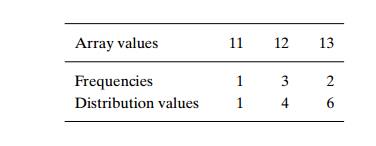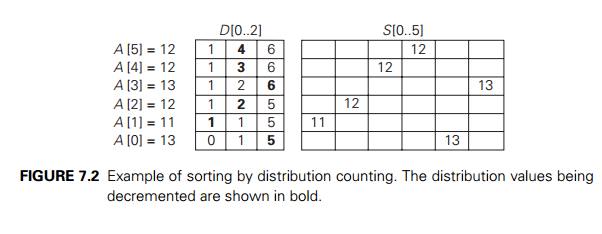Chapter: Introduction to the Design and Analysis of Algorithms : Space and Time Trade-Offs
Sorting by Counting
Sorting by Counting
As a first example of
applying the input-enhancement technique, we discuss its application to the
sorting problem. One rather obvious idea is to count, for each element of a
list to be sorted, the total number of elements smaller than this element and
record the results in a table. These numbers will indicate the positions of the
elements in the sorted list: e.g., if the count is 10 for some element, it
should be in the 11th position (with index 10, if we start counting with 0) in
the sorted array. Thus, we will be able to sort the list by simply copying its
elements to their appropriate positions in a new, sorted list. This algorithm
is called comparison-counting sort (Figure 7.1).

ALGORITHM ComparisonCountingSort(A[0..n ŌłÆ 1])
//Sorts an array by
comparison counting
//Input: An array A[0..n ŌłÆ 1] of orderable elements
//Output: Array S[0..n ŌłÆ 1] of AŌĆÖs elements sorted in nondecreasing order for i ŌåÉ 0 to n ŌłÆ 1 do Count[i] ŌåÉ 0
for i ŌåÉ 0 to n ŌłÆ 2 do
for j ŌåÉ i + 1 to n ŌłÆ 1 do
if A[i] < A[j ]
Count[j ] ŌåÉ Count[j ] + 1 else Count[i] ŌåÉ Count[i] + 1
for i ŌåÉ 0 to n ŌłÆ 1 do S[Count[i]] ŌåÉ A[i] return
S
What is the time efficiency
of this algorithm? It should be quadratic because the algorithm considers all
the different pairs of an n-element array. More
formally, the number of times its basic operation, the comparison A[i] < A[j ], is executed is equal to the sum we have
encountered several times already:

Thus, the algorithm makes the
same number of key comparisons as selection sort and in addition uses a linear
amount of extra space. On the positive side, the algorithm makes the minimum
number of key moves possible, placing each of them directly in their final
position in a sorted array.
The counting idea does work
productively in a situation in which elements to be sorted belong to a known
small set of values. Assume, for example, that we have to sort a list whose
values can be either 1 or 2. Rather than applying a general sorting algorithm,
we should be able to take advantage of this additional information about values
to be sorted. Indeed, we can scan the list to compute the number of 1ŌĆÖs and the
number of 2ŌĆÖs in it and then, on the second pass, simply make the appropriate
number of the first elements equal to 1 and the remaining elements equal to 2.
More generally, if element values are integers between some lower bound l and upper bound u, we can compute the frequency of each of those
values and store them in array F [0..u ŌłÆ l]. Then the first F [0] positions in the sorted list must be
filled with l, the next F [1] positions with l + 1, and so on. All this can be done, of course,
only if we can overwrite the given elements.
Let us consider a more
realistic situation of sorting a list of items with some other information
associated with their keys so that we cannot overwrite the listŌĆÖs elements.
Then we can copy elements into a new array S[0..n ŌłÆ 1] to hold the sorted list as follows. The
elements of A whose values are equal to
the lowest possible value l are copied into the first F [0] elements of S, i.e., positions 0 through F [0] ŌłÆ 1; the elements of value l + 1 are copied to positions from F [0] to (F [0] + F [1]) ŌłÆ 1; and so on. Since such accumulated sums of
frequencies are called a distribution in statistics, the method itself is known
as distribution
counting.
EXAMPLE Consider sorting the array

whose values are known to
come from the set {11, 12, 13} and should not be overwritten in the process
of sorting. The frequency and distribution arrays are as follows:

Note that the distribution
values indicate the proper positions for the last occur-rences of their
elements in the final sorted array. If we index array positions from 0 to n ŌłÆ 1, the distribution values must
be reduced by 1 to get corresponding element positions.
It is more convenient to
process the input array right to left. For the example, the last element is 12,
and, since its distribution value is 4, we place this 12 in position 4 ŌłÆ 1 = 3 of the array S that will hold the sorted list. Then we
decrease the 12ŌĆÖs distribution value by 1 and proceed to the next (from the
right) element in the given array. The entire processing of this example is
depicted in Figure 7.2.

Here is pseudocode of this
algorithm.
ALGORITHM DistributionCountingSort(A[0..n ŌłÆ 1],
l, u)
//Sorts an array of integers
from a limited range by distribution counting //Input: An array A[0..n ŌłÆ 1] of integers between l and u (l Ōēż u) //Output: Array S[0..n ŌłÆ 1] of AŌĆÖs elements sorted in nondecreasing order for j ŌåÉ 0 to u ŌłÆ l do D[j ] ŌåÉ 0 //initialize frequencies
for i ŌåÉ 0 to n ŌłÆ 1 do D[A[i] ŌłÆ l] ŌåÉ D[A[i] ŌłÆ l] + 1 //compute frequencies
for j ŌåÉ 1 to u ŌłÆ l do D[j ] ŌåÉ D[j ŌłÆ 1] + D[j ] //reuse for
distribution
for i ŌåÉ n ŌłÆ 1 downto 0 do
j ŌåÉ A[i] ŌłÆ l
S[D[j ] ŌłÆ 1] ŌåÉ A[i]
D[j ] ŌåÉ D[j ] ŌłÆ 1
return S
Assuming that the range of
array values is fixed, this is obviously a linear algorithm because it makes
just two consecutive passes through its input array A. This is a better time-efficiency class than
that of the most efficient sorting algorithmsŌĆömergesort,
quicksort, and heapsortŌĆöwe have encountered. It is im-portant to remember,
however, that this efficiency is obtained by exploiting the specific nature of
inputs for which sorting by distribution counting works, in addi-tion to
trading space for time.
Is it possible to exchange numeric values of two variables, say, u and v, without using any extra storage?
Will the comparison-counting algorithm work correctly for arrays
with equal values?
Assuming that the set of possible
list values is {a, b, c, d}, sort the
following list in alphabetical order by the distribution-counting algorithm:

Is the distribution-counting algorithm stable?
Design a one-line algorithm for sorting any array of size n whose values are n distinct integers from 1 to n.
The ancestry problem asks to determine whether a vertex u is an ancestor of vertex v in a given binary (or, more generally, rooted
ordered) tree of n vertices. Design a O(n) input-enhancement algorithm that provides
sufficient information to solve this problem for any pair of the treeŌĆÖs
vertices in constant time.
The following technique, known as virtual initialization,
provides a time-efficient way to initialize just some elements of a given array
A[0..n ŌłÆ 1] so that for each of its elements, we can
say in constant time whether it has been initialized and, if it has been, with
which value. This is done by utilizing a variable count er for the number of initialized elements in A and two auxiliary arrays of the same size, say
B[0..n ŌłÆ 1] and C[0..n ŌłÆ 1], defined as follows. B[0],
. . . , B[count er ŌłÆ 1] contain the indices of the elements of A that were initialized: B[0] contains the index of the element
initialized first, B[1] contains the index of the
element initialized second, etc. Furthermore, if A[i] was the kth element (0 Ōēż k Ōēż count er ŌłÆ 1) to be initialized, C[i] contains k.
Sketch the state of arrays A[0..7], B[0..7], and C[0..7] after the three
as-signments

In general, how can we check with this scheme whether A[i] has been initialized and,
if it has been, with which value?
Least distance sorting There are 10 Egyptian stone
statues standing in a row in an art
gallery hall. A new curator wants to move them so that the statues are ordered
by their height. How should this be done to minimize the total distance that
the statues are moved? You may assume for simplicity that all the statues have
different heights. [Azi10]
a. Write a program for
multiplying two sparse matrices, a p ├Ś q matrix A and a q ├Ś r matrix B.
b. Write a program for multiplying two sparse polynomials p(x) and q(x) of degrees m and n, respectively.
Related Topics